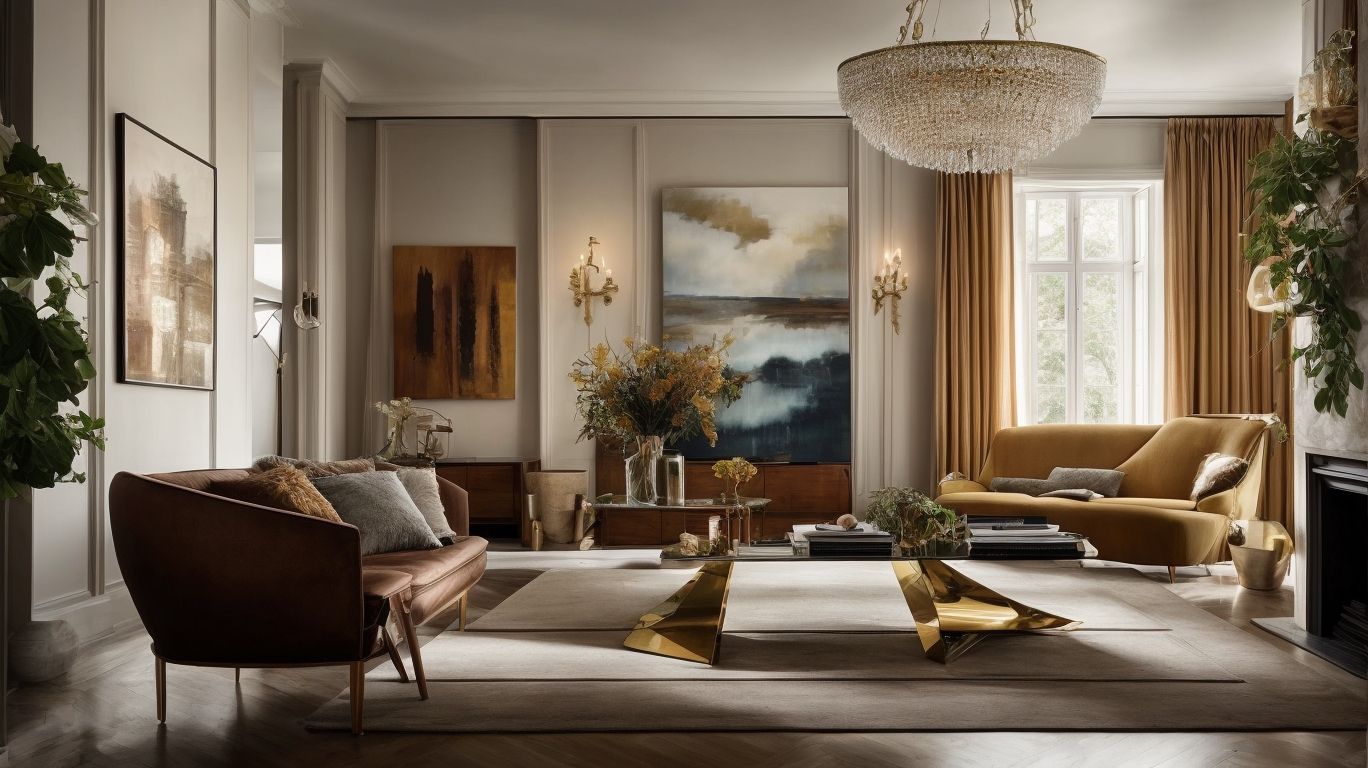Are you looking to revamp your home’s interior design but don’t know where to start? Look no further! As our living spaces become more important in our daily lives, it’s vital to create a space that reflects our personalities and brings us joy. In this article, we’ll explore tips and tricks to achieve a designer-style home without breaking the bank.
What Are the Basics of Interior Design?
Aspiring to transform your living space into a stylish and functional haven? Look no further than the basics of interior design. In this section, we will discuss the fundamental principles that every interior designer swears by. From understanding color theory to utilizing texture and patterns, we will dive into the key elements that can bring your design vision to life. By the end, you will have a better understanding of the fundamentals of interior design that will serve as a strong foundation for your own unique style.
1. Understanding Color Theory
- The knowledge of Understanding Color Theory is essential for interior design as it encompasses the study of color harmonies, contrasts, and color schemes.
- Begin by understanding the color wheel and its relationships to create balanced and visually appealing interiors.
- Discover the psychological effects of colors to evoke desired emotions and moods in various living spaces.
- Comprehend the influence of natural and artificial lighting on the perception of color within a room.
2. Knowing Different Design Styles
- Modern: Emphasizes simplicity, clean lines, and functionality.
- Contemporary: Characterized by current trends, often incorporating bold colors and unconventional furniture.
- Traditional: Reflects classic European decor, featuring ornate details and luxurious furnishings.
- Transitional: Blends traditional and contemporary styles, creating a timeless and comfortable design.
- Mid-Century Modern: Showcases designs from the mid-20th century, focusing on functionality and natural shapes.
- Understanding Various Design Styles
3. Utilizing Texture and Patterns
- Incorporate various textures such as velvet, silk, or linen to add depth and visual interest to the space.
- Experiment with patterns by mixing geometric, floral, and abstract designs to create a dynamic and balanced look.
- Take into consideration the scale of patterns to ensure they complement the size of the room and furniture.
- Layer different textures using rugs, throws, and cushions to create a cozy and inviting atmosphere.
How Can I Style My House Like an Interior Designer?
Have you ever wondered how interior designers create such beautifully curated spaces? The key is to have a well thought out plan and attention to detail. In this section, we will discuss five essential elements that interior designers use to style a house. From creating a focal point to incorporating different textures and personal touches, you’ll learn how to elevate your home’s aesthetic to a professional level. So, let’s dive in and discover how you can style your house like an interior designer.
1. Start with a Plan
- Assess the space and determine its function.
- Set realistic goals and establish a budget.
- Research and gather inspiration from various sources such as magazines, websites, and social media.
- Create a mood board to visually organize your ideas and preferences.
- Identify the design style and color scheme that aligns with your vision.
2. Choose a Focal Point
- Assess the Space: Identify the most visually dominant area or element in the room, such as a fireplace or a large window.
- Emphasize the Focal Point: Use design techniques like color contrast, lighting, or placement of furniture to draw attention to the chosen focal point, as instructed in step 2.
- Avoid Competing Elements: Ensure other design elements in the space complement, rather than detract from, the focal point.
3. Incorporate Different Textures and Patterns
- Layer textures: Combine various textures like smooth, rough, and fluffy to add depth and visual interest to the design.
- Mix patterns: Pair different patterns, such as stripes and florals, in similar color schemes to create cohesion and balance.
- Consider scale: Find a balance between large and small patterns to avoid overwhelming the space.
Pro-tip: When incorporating different textures and patterns, make sure to use a cohesive color palette to maintain visual harmony in the design.
4. Play with Lighting
- Assess the space: Identify areas that require lighting, such as task lighting for work areas and ambient lighting for living spaces.
- Choose the right fixtures: Select fixtures that complement the design style and provide sufficient illumination.
- Layer the lighting: Combine ambient, task, and accent lighting to create a balanced and inviting atmosphere.
- Utilize natural light: Maximize natural light by strategically placing windows and incorporating light-colored decor.
When experimenting with lighting, it is important to consider both the functionality and aesthetics of each light source in order to achieve a well-lit and visually appealing space.
5. Add Personal Touches
- Display Personal Collections: Showcase items that hold sentimental value or reflect your personality, such as artwork, souvenirs, or family heirlooms.
- Customize Accessories: Personalize the space with customized cushions, throws, or photo frames featuring cherished memories.
- Create DIY Decor: Incorporate handmade crafts or decorations that resonate with your interests and hobbies.
- Showcase Hobby Items: Highlight your hobbies through dedicated spaces like a reading nook, music corner, or art display.
- Personalize Functional Items: Customize everyday items like mugs, coasters, or doormats with monograms or favorite quotes.
What Are Common Design Mistakes to Avoid?
Aspiring interior designers often struggle with creating a cohesive and visually appealing space. One of the biggest challenges is avoiding common design mistakes that can hinder the overall aesthetic. In this section, we will discuss the most common design mistakes to avoid when styling your home. From overcrowding the space to ignoring scale and proportion, we will cover how to recognize and prevent these pitfalls in your design process.
1. Overcrowding the Space
- Declutter: Remove unnecessary furniture or decorative items to create breathing space and visual harmony, avoiding overcrowding the space.
- Multi-functional pieces: Opt for furniture that serves dual purposes, such as storage ottomans or sofa beds, maximizing utility without overcrowding.
- Vertical storage: Utilize wall shelves, hanging organizers, or tall bookcases to free up floor space and prevent overcrowding.
- Open layout: Embrace an open floor plan to impart a sense of spaciousness, preventing the feeling of overcrowding the space.
2. Not Considering Functionality
- When designing a space, always consider its purpose and intended use.
- Make sure that the furniture and layout are suitable for the intended function.
- Avoid over-furnishing in order to maintain a good flow and practicality.
- Include storage solutions to avoid clutter and make the most of the available space.
A friend of mine made the mistake of not considering functionality when designing her living room, resulting in furniture that was beautiful but not practical. She had to rearrange the layout to achieve a balance of style and functionality.
3. Ignoring Scale and Proportion
- Measure furniture and select appropriate sizes for the space.
- Balance large furniture with ample open space and avoid clutter.
- Consider the scale of patterns and textures to ensure visual harmony.
Here’s a true story: In a rush to decorate, a friend overlooked the importance of scale and proportion and purchased an oversized sofa, resulting in a crowded living room. After reassessing, they exchanged it for a smaller one, instantly transforming the room into a welcoming and well-proportioned space.
How Can I Keep My Design Timeless?
Creating a timeless design for your home is a goal that many homeowners strive for. It’s a way to ensure that your space will always feel stylish and relevant, no matter how much time passes. In this section, we’ll explore four key principles that can help you achieve a timeless look in your home. From sticking to classic styles to incorporating trends in small doses, these tips from interior designers will guide you towards a timeless and sophisticated design that will stand the test of time.
1. Stick to Classic Styles
- Choose timeless furniture pieces like Chesterfield sofas or Mid-century modern chairs.
- Opt for classic architectural details such as crown molding and wainscoting.
- Use traditional patterns like stripes, plaids, and florals in upholstery or drapery.
- Incorporate vintage or antique accents like ornate mirrors or chandeliers.
- Stick to a neutral color palette for walls, then add pops of color with accessories.
2. Use Neutral Colors
- Opt for a neutral color scheme when choosing wall colors, such as whites, beiges, or grays.
- Select neutral shades for larger furniture pieces like sofas and chairs.
- Add in neutral-colored decorative items like rugs, curtains, and throw pillows to accessorize.
- Incorporate natural elements in neutral tones, such as wood and stone, for a balanced look.
- Add pops of color through artwork, plants, or accent pieces to balance out the neutral colors.
3. Invest in Quality Pieces
- Research: When making purchases, prioritize reputable brands and materials known for their durability and longevity.
- Functionality: It is important to choose pieces that not only offer aesthetic appeal but also serve a practical purpose.
- Maintenance: Take into consideration the ease of maintenance and the material’s ability to withstand wear and tear.
- Timelessness: Opt for designs that are timeless and will not be affected by changing trends and evolving styles.
4. Incorporate Trends in Small Doses
- Stay Timeless: Emphasize classic styles as the foundation, incorporating trendy elements in small doses.
- Accent Pieces: Introduce trends in small doses as accent pieces like throw pillows, rugs, or wall art.
- Temporary Decor: Experiment with temporary decor such as removable wallpaper or decals to incorporate trends without a long-term commitment.








